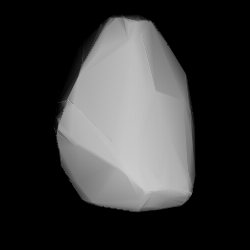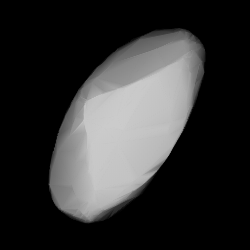
722 Frieda is a bright background asteroid and slow rotator from the inner regions of the asteroid belt. It was discovered by Austrian astronomer Johann Palisa at the Vienna Observatory on 18 October 1911. The stony S-type asteroid has a notably long rotation period of 131.1 hours and measures approximately 9 kilometers in diameter. It was named after Frieda Hillebrand, daughter of Austrian astronomer Karl Hillebrand (1861–1939), and grand-daughter of Edmund Weiss (1837–1917) who had been the director of the discovering observatory.

759 Vinifera is a large background asteroid from the central regions of the asteroid belt, approximately 50 kilometers in diameter. It was discovered on 26 August 1913, by German astronomer Franz Kaiser at the Heidelberg-Königstuhl State Observatory in southwest Germany. The dark X-type asteroid has a rotation period of 14.2 hours and a heavily elongated shape. It was named after the plant species vitis vinifera, also known as the common grape vine.

810 Atossa is a bright and elongated background asteroid from the region of the Flora family, located in the inner portion of the asteroid belt. It was discovered on 8 September 1915, by German astronomer Max Wolf at the Heidelberg-Königstuhl State Observatory in southern Germany. The presumed S-type asteroid has a rotation period of 4.4 hours and measures approximately 8 kilometers in diameter. It was named after the ancient Persian queen Atossa.
941 Murray is a background asteroid, approximately 18 kilometers in diameter, located in the central region of the asteroid belt. It was discovered by Austrian astronomer Johann Palisa at the Vienna Observatory on 10 October 1920. The X-type asteroid has a short rotation period of 3.4 hours. It was named after British professor Gilbert Murray (1866–1957).
Arago, provisional designation 1923 OT, is a dark asteroid from the outer regions of the asteroid belt, approximately 55 kilometers in diameter. It was discovered on 5 September 1923, by Russian astronomer Sergey Belyavsky at the Simeiz Observatory on the Crimean peninsula. The asteroid was named after French mathematician François Arago.
Pawlowia, provisional designation 1923 OX, is a background asteroid from the central regions of the asteroid belt, approximately 20 kilometers in diameter. It was discovered on 5 October 1923, by Soviet astronomer Vladimir Albitsky at the Simeiz Observatory on the Crimean peninsula. The asteroid was named after Russian physiologist and Nobelist Ivan Pavlov.

1032 Pafuri, provisional designation 1924 SA, is a dark background asteroid from the outer regions of the asteroid belt, approximately 65 kilometers in diameter. It was discovered on 30 May 1924, by English astronomer Harry Edwin Wood at the Union Observatory in Johannesburg, South Africa. The asteroid was named for the river in the Pafuri Triangle in South Africa, created by the confluence of the Limpopo and Levubu rivers. The body's spectral type and rotation period are still poorly determined.
3181 Ahnert, provisional designation 1964 EC, is a stony Flora asteroid from the inner regions of the asteroid belt, about 8 kilometers in diameter. It was discovered by German astronomer Freimut Börngen at the Karl Schwarzschild Observatory in Tautenburg, eastern Germany, on 8 March 1964.
1918 Aiguillon provisional designation 1968 UA, is a dark asteroid from the outer region of the asteroid belt, approximately 20 kilometers in diameter.

1457 Ankara, provisional designation 1937 PA, is a stony asteroid from the central region of the asteroid belt, approximately 18 kilometers in diameter. It was discovered on 3 August 1937, by German astronomer Karl Reinmuth at Heidelberg Observatory in southwest Germany, and later named for the Turkish capital city of Ankara.

2839 Annette is a bright Flora asteroid from the inner regions of the asteroid belt. It was discovered on 5 October 1929, by American astronomer Clyde Tombaugh at Lowell Observatory during his search for Pluto. The presumed S-type asteroid has a rotation period of 10.5 hours and measures approximately 5 kilometers in diameter. It was named after the discoverer's daughter.
2033 Basilea, provisional designation 1973 CA, is a stony asteroid from the inner regions of the asteroid belt, approximately 6 kilometers in diameter. It was discovered on 6 February 1973, by astronomer Paul Wild at the Zimmerwald Observatory near Bern, Switzerland. The asteroid was named for the Swiss city of Basel.
1815 Beethoven, provisional designation 1932 CE1, is a carbonaceous background asteroid from the outer regions of the asteroid belt, approximately 30 kilometers (19 miles) in diameter. It was discovered on 27 January 1932, by German astronomer Karl Reinmuth at the Heidelberg Observatory. The uncommon F-type asteroid seems to have a long rotation period of 54 hours (tentative). It was named after Ludwig van Beethoven.
2034 Bernoulli, provisional designation 1973 EE, is a stony asteroid from the inner regions of the asteroid belt, approximately 9 kilometers in diameter.
1261 Legia, provisional designation 1933 FB, is a dark Themistian asteroid from the outer regions of the asteroid belt, approximately 32 kilometers in diameter. It was discovered on 23 March 1933, by astronomer Eugène Delporte at the Royal Observatory of Belgium in Uccle. The asteroid was named for the Belgian city of Liège (Luke).
3066 McFadden, provisional designation 1984 EO, is a stony background asteroid from the central regions of the asteroid belt, approximately 15 kilometers in diameter. It was discovered on 1 March 1984, by American astronomer Edward Bowell at the Anderson Mesa Station near Tucson, Arizona. It was named for American planetary scientist Lucy-Ann McFadden. The assumed S-type asteroid has a rotation period of 13.8 hours.
7476 Ogilsbie, provisional designation 1993 GE, is a carbonaceous asteroid from the outer region of the asteroid belt, approximately 20 kilometers in diameter. It was discovered by American astronomer Timothy Spahr at the U.S. Catalina Station in Tucson, Arizona, on 14 April 1993.
1990 Pilcher, provisional designation 1956 EE, is a stony background asteroid from the Florian region of the inner asteroid belt, approximately 7 kilometers in diameter. It was discovered on 9 March 1956, by German astronomer Karl Reinmuth at the Heidelberg-Königstuhl State Observatory in Heidelberg, Germany. In 1982, it was named by the MPC for American physicist and photometrist Frederick Pilcher. The S-type asteroid has a short rotation period of 2.8 hours.

2384 Schulhof (prov. designation: 1943 EC1) is a mid-sized asteroid and the namesake of the Schulhof family, located in the Eunomian region of the intermediate asteroid belt. It was discovered on 2 March 1943, by French astronomer Marguerite Laugier at Nice Observatory in southeastern France. The asteroid was later named after Hungarian astronomer Lipót Schulhof. The presumed S-type asteroid has a short rotation period of 3.3 hours and measures approximately 12 kilometers (7.5 miles) in diameter.
1530 Rantaseppä, provisional designation 1938 SG, is a stony Florian asteroid from the inner regions of the asteroid belt, approximately 5 kilometers in diameter. Discovered by Yrjö Väisälä at Turku Observatory in 1938, it was later named after Finnish astronomer Hilkka Rantaseppä-Helenius.






